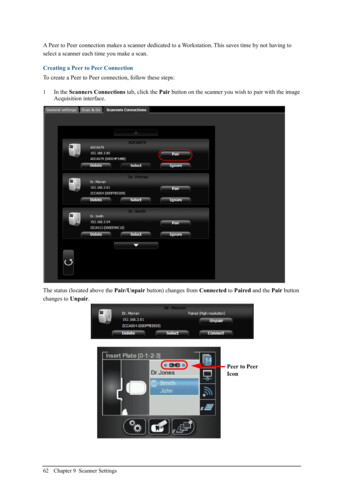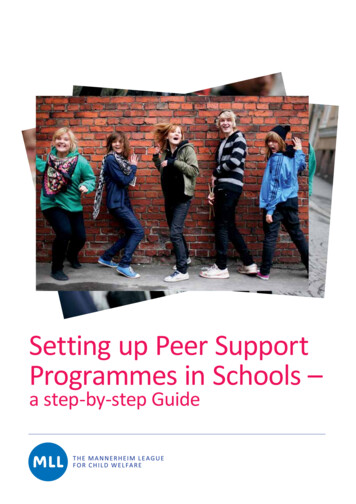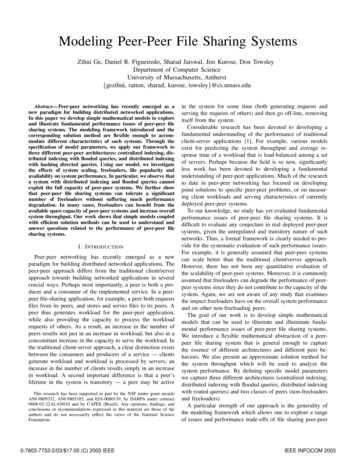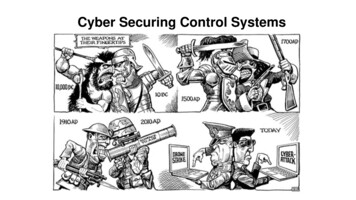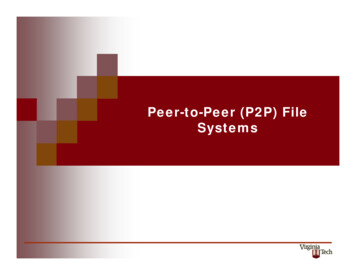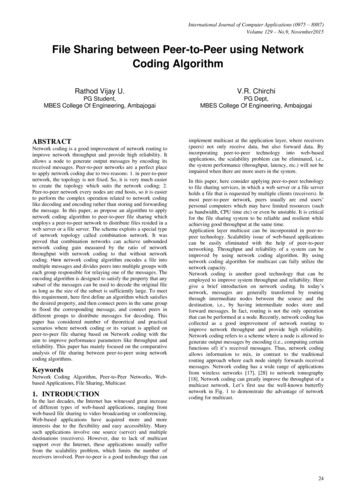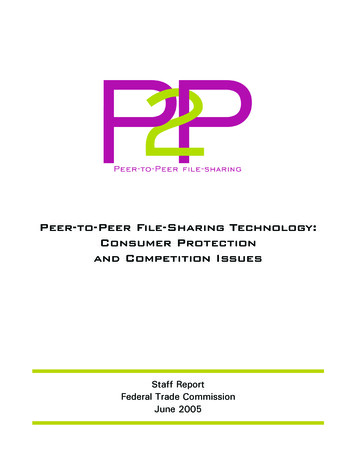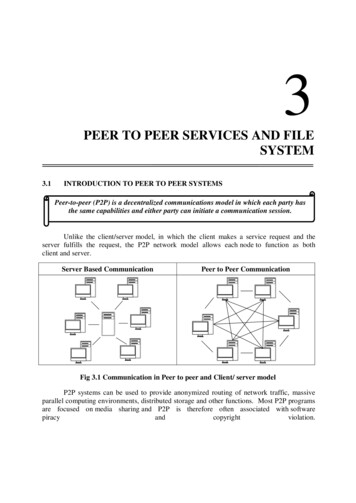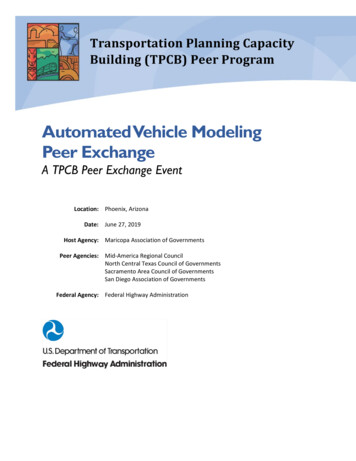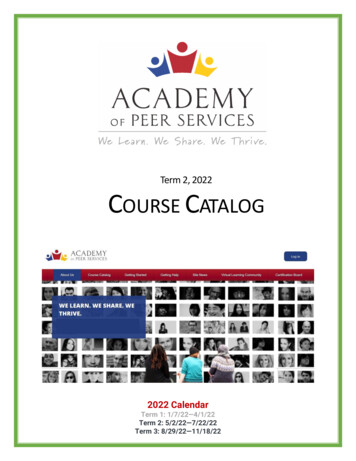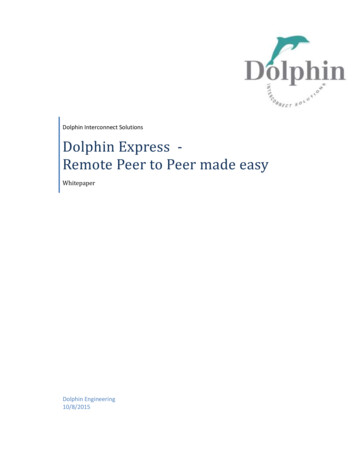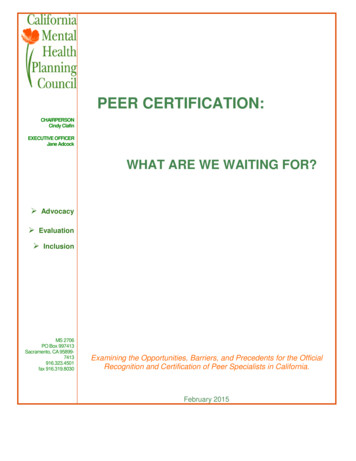
Transcription
PEER CERTIFICATION:CHAIRPERSONCindy ClafinEXECUTIVE OFFICERJane AdcockWHAT ARE WE WAITING FOR? Advocacy Evaluation InclusionMS 2706PO Box 997413Sacramento, CA 958997413916.323.4501fax 916.319.8030Examining the Opportunities, Barriers, and Precedents for the OfficialRecognition and Certification of Peer Specialists in California.February 2015
California Mental Health Planning CouncilFebruary 2015“When you talk to people who have been through these programs and ask them whathelped them, it is not the drugs, not the diagnosis. It's the lasting, one-on-onerelationships with adults who listen 56640026/halting-schizophrenia-before-it-starts
Leading the Way, yet Lagging Behind:California is accustomed to being at the forefront of progressive, compassionate policy andlegislation. Voters passed the Mental Health Services Act because they couldn’t stand to seethe misery of unaddressed mental illness and the state was an early adopter of parity laws andMedicaid expansion. As a state, we have been proud of our leadership. So, where hasCalifornia lagged behind? California has yet to follow the example of 31 other states and theVeterans Administration in establishing and utilizing a standardized curriculum and certificationprotocol for Peer Specialists' services.Peers are persons with lived experience as consumers and family members or caretakers ofindividuals living with mental illness. Their experiences make Peer Specialists invaluablemembers of a service team. Employment and certification simultaneously bridges the gapbetween those that need it and those that can best provide it while reinforcing the peerprovider’s own wellness and sense of purpose.Right now, more than half of the United States has a Peer Certification Program in place –people practicing, producing, and billing. Making a difference in the lives of people theyintimately understand because they have already staved off the same potential devastation.Because if you ask somebody struggling with a life-altering, all-consuming episode of any typeof mental distress if they have sought help yet, the response - more often than not - would be“'they don’t understand” or “I just can’t deal with the process of getting that help”. Californiahas not been able to summon up the political will it would take to make the most basic andmeaningful connection with somebody who needs it the most.“A leader is not someone who stands before you, but someone who stands with you 2”What are Peer Specialists?Peer Specialists are empathetic guides and coaches who understand and model the processof recovery and healing while offering moral support and encouragement to people who needit. Moral support and encouragement have proven to result in greater compliance withtreatment/services, better health function, lower usage of emergency departments, fewermedications and prescriptions, and a higher sense of purpose and connectedness on the partof the consumer.Peer Specialists also model and train on communication between health care provider andconsumer in order to educate both on potential barriers or side effects of existing medicationsor treatment plans. In a world where primary care intersects with mental health care, but2Native American Proverb1
medical records are not necessarily shared, this alone is huge. Bridging that gap becomes oneof the single highest predictors of effective treatment plans and positive outcomes. In apopulation with mortality rates that average 25 years sooner than non-SMI groups - forconditions that could be easily managed or cured - this one benefit alone is worth theinvestment.It might be easier to describe Peer specialists by defining what they are NOT. Peer Specialistsdiffer from Case Managers in that they do not identify resources, arrange for social orsupportive services, or facilitate job trainings, educational opportunities, or livingarrangements. They are not certified to offer medical advice or diagnoses, psychiatric orotherwise, or suggest, prescribe, or manage medications. Their function is not to “do for” butrather to “do with” and ultimately model and train wellness principles and self-sufficiency.What is Peer Specialist Certification?Peer Specialist Certification is an official recognition by a certifying body that the practitionerhas met qualifications that include lived experience and training from a standardizedcurriculum on mental health issues. The standardized curriculum has been approved by thecertifying body and includes a mandatory number of hours of training in various topicspertaining to mental health care, coaching, and ethics. The “specialist” designation is conferredwhen additional hours of training specific to special populations or age groups has beencompleted and the candidate has demonstrated thorough knowledge, skills, and ability withinthat subgroup.The standardized curriculum includes topics such as documentation, boundaries and ethics,communication skills, working with specific populations, developing wellness plans, systems ofcare, principles of practices (i.e., engagement, strength-based planning, WRAP plans, casemanagement); and advocacy, to name a few. At this time, there are several courses availablethrough the community college system, but not on a statewide basis. Working Well Togetherhas compiled an excellent comprehensive report - Certification of Consumer, Youth, Family,and Parent Providers; A Review of the Research – which provides detailed information,background, and context. 3Why Certification?“Regardless of the means selected to demonstrate competency, it is critical that thecore competencies of a peer (knowledge, skills, job tasks, and performance domains ofthe profession) are identified according to a recognized process, such as a job taskanalysis or role delineation study. This is because –all other program requirements,policies, and standards must tie back to the core competencies of the professionbeing credentialed.” 43http://www.inspiredatwork.net/uploads/WWT Peer Certification Research Report FINAL 6.20.12 1 .pdf4Hendry, P., Hill, T., Rosenthal, H. Peer Services Toolkit: A Guide to Advancing and Implementing Peer-runBehavioral Health Services. ACMHA: The College for Behavioral Health Leadership and Optum, 20142
Defining and standardizing the classification of Peer Specialist through certification preventsengagement outside one’s expertise. Like any other profession, the certification defines thelevel of care and services so that the parameters established by the standardized curriculumand certification requirements are respected and understood statewide. Any hiring organizationcan expect these levels of qualifications, training, and expertise in the person they hire and canplan their organizational functions around the duties encompassed by that expertise. It alsoprovides guidance to the peer practitioner through an established code of ethics. This meansthat roles and functions of other providers will not be usurped or second-guessed by the PeerSpecialists.The role of the certified peer specialist is to encourage partners and lead through example onthe best ways to advocate for oneself. Sometimes it is not enough to suggest resources andmake recommendations for services – sometimes you have to walk the walk along with theperson for the first few steps, or even the first few miles. In this respect, the Peer Specialist isthe Sherpa of the mental health care world. As partners, they teach participants how tocommunicate with care providers, navigate insurance companies and bureaucracies, andlessen the anxieties that arise from these various interactions. As models, they demonstratethat recovery is possible.The Time is NowFirst and foremost, the time is now because Affordable Health Care, Mental Health Parity,Coordinated Care Initiative, and potentially even the Public Safety Realignment createworkforce shortages, particularly in the area of rehabilitative services. The time is now becauserecognizing the value of Peer Specialists does not translate into standardized training, skillsets, duties, or pay scales. This will make it difficult to operationalize and maintain utilization ona scale sufficient to meet the workforce needs or government standards and requirements forreimbursement. In other words “failing to plan is planning to fail”.The Center for Medicaid Services gave California permission to amend its State Plan toinclude Peer Providers in 2007, stating “We encourage States to consider comprehensiveprograms but note that regardless of how a State models its mental health and substance usedisorder service delivery system, the State Medicaid agency continues to have the authority todetermine the service delivery system, medical necessity criteria, and to define the amount,duration, and scope of the service” 5.The time is now because the state is starting to fully understand the concept and value of peerservices as part of both mental health care and the larger arena of primary care. Examples ofthis are their inclusion in the SB 82 (Steinberg) Investment in Mental Health and Wellness Act5Center for Medicare and Medicaid Services; SMDL #07-011; August 15, 20073
grant requirements for mobile crisis teams; the intent in the original Prop 63 language toinclude peers, family members, and parent providers as part of the MHSA workforce; and aone-time dedicated state budget allocation of training funds to the Office of StatewideHealth Planning and Development for peers to be trained as mobile crisis team members. Allof these components will be working together as part of the larger mental health network ofcare, but run the risk of operating at disparate training levels, scope of work, code of ethics,and pay levels from county to county.Finally, the time is now because trying to standardize the classification after a piecemealacceptance is put into place is inefficient and uninformative to potential employers. Moreover, itis unfair to people who are willing to share their expertise and demonstrate their commitmentto this important and effective aspect of care and services.To draw a timely comparison, the classification of drug and alcohol counselors, which oftenhas a strong peer component as part of the qualifications for employment, received an earlywelcome into the workforce. However, this acceptance was unaccompanied by any definedtraining, experience, or education requirements. There has been an attempt to retroactivelyachieve some standardization across the lines, but proponents are finding that, due to theunstructured engagement of their services, there is no uniform requirement or skill level acrosstreatment sites. Worse, there is a reluctance to champion a certification process, due topotential hardships and setbacks created for current successful peer employees who might notmeet certification standards after the fact.Is it Cost-Effective?In Alameda County, a Peer Mentoring pilot project provided 40 hours of training to 26 peerscalled “The Art of Facilitating Self-Determination” and matched them with people recentlyreleased from psychiatric hospitals. Those accepting a peer mentor experienced a 72%reduction in readmissions to the hospital. The cost savings for Alameda County was over amillion dollars with an initial investment of 238K- making a 470% return on investment 6.The Pew Trusts reported recently “In Georgia, a 2003 study compared patients diagnosed withschizophrenia, bipolar disorder and major depression whose treatment had included peersupport, with patients who received traditional day treatment services without peers. Thepatients who had peer support had better health outcomes—and at a lower cost. The averageannual cost of day treatment services is 6,400 per person, while support services cost about mental-health-workershortage ; last accessed 11/5/20144
Who Employs Peer Specialists?Between October 2013 and January 2015, the Advocacy Committee of the California MentalHealth Planning Council (CMHPC) heard presentations from Peer Specialist Advocates andPeer-run programs throughout the state. The programs represented different models rangingfrom peer-run respites to peer partners in health care, but all of them reported positiveoutcomes for the participants, cost savings for their respective counties, and a bolstering oftheir own wellness commitment. Here is a brief review of a few of the models the AdvocacyCommittee heard from.Health Navigators USCThe Peer Health navigator connects consumers to mental health, primary care, substance use,and specialty health care services; teaches them how to advocate for themselves andeffectively communicate their needs; create a follow-up plan and other self-management skillsthrough a “modeling, coaching, fading”. They differ from Case Managers or care coordinatorsin that the health navigator will ultimately step away from the participant once themodeling/coaching/fading process is successful.Typically a full-time navigator will have 12 – 15 clients at any one time, and averages 30-40clients annually, depending on how quickly the clients moves into full self-management. Manyof the services are Medicaid billable under Targeted Case Management or Rehabilitationproviding the documentation reflects justification for the services rendered. Participants aretrained on billing codes and documentation. The program has developed its own curriculumand provides its own training and certification.2nd Story, Santa Cruz2nd Story is a SAMHSA-funded program that is an entirely Peer-Run Crisis Center in SantaCruz. All staff are trained in “Intentional Peer Support” and all wellness class topics aredetermined by the guests. The program provides its own training. The length of stay is nolonger than two weeks, and guests are encouraged to maintain their “normal” life (school,work) during their stay. Outreach is conducted by staff posted at County mental healthdepartments telling potential guests about the program. Referrals are also made bypsychiatrists, care managers, and Telecare, a county mental health servicesprovider/contractor, sometimes diverts people to 2nd Story rather than enrolling them in alonger term, more structured social rehabilitation facility. The program is proving to be a keypreventative service in Santa Cruz that forestalls or reduces the need for crisis residential andsub-acute stabilization programs.5
In-Home Outreach Team (IHOT), San DiegoAs Assisted Outpatient Treatment steadily gains ground in more California counties, a smallprogram in San Diego is providing an effective and legitimate alternative at promoting andfacilitating voluntary access to services. IHOT teams consist of a Peer Specialist, familymember, personal service coordinator and team lead. They provide in-home outreach to adultswith serious mental illness (SMI) who are reluctant or resistant to receiving mental healthservices. IHOT also provides support and education to family members and/or caretakers ofIHOT participants. They work with individuals living with severe mental illness and who mayalso be dually diagnosed with a substance use disorder or drug dependency. Teams serve acombined 240-300 consumers per year (80-100 per team).A 2013 San Diego Health and Human Services report notes that the average cost per IHOTparticipant amounts to 8,100, compared to an annual cost per individual in a Full ServicePartnership ( 20,000 including housing) and Assisted Outpatient Treatment ( 34,000). Staffratios are similarly proportionate: IHOT 1:25 staff to client ratio; FSP and AOT each have a1:10 staff to client ratio.What Other States Employ and Certify Peer Specialists?As of 2013, Certified Peer Specialists were certified and employed in 31 states and the federalDepartment of Veteran’s Affairs. The extent of engagement and responsibility varies from stateto state, but all services are Medicaid billable. These 31 states are consistent in their belief andtrust in Peer Specialists – when will California join them?What is Stopping California?Despite all of the merits, fiscal and clinical, of Certified Peer Specialists, California has notbeen able to match its actions to its talk in this area. California embraces the concept ofrecovery, wellness, and resilience – and recognizes the essential components of bothemployment and inclusion as part of those processes – but it has failed to turn those conceptsto tangible actions.No State Department feels that it is in their purview to establish, implement or oversee a statecertification process. Education may approve a curriculum, but it is not empowered to grantcertification. Department of Health Care Services may be able to approve billable services, butis not empowered to establish curriculum or gage mastery of the subject matter. The Office ofStatewide Health Planning and Development (OSHPD) has a Workforce DevelopmentDivision, and is specifically charged with mental health workforce development issues, butwithout specific language or policy permitting OSHPD to include or pursue the specificclassification of Peer Specialist, OSHPD does not felt comfortable facilitating it. In short, thesingle, largest barrier has been the identification of a lead agency or organization that can becharged with facilitation, implementation, and identification of a certification and oversight6
body. There may be philosophical or conceptual agreement on the importance of PeerSpecialists, but no policy or political direction to move it forward.How Can California Catch Up?Peer Specialist Certification is a cross-cutting, inclusive, and cost-saving classification that hasapplications across all vulnerable and at-risk populations in the state – veterans, homeless,Transition Age Youth, elderly, and criminal justice populations to name a few - and hasparticular utility in integrated services for the dually diagnosed and co-morbid conditions inhealth care.The California Mental Health Planning Council (CMHPC) recommends that the Legislaturecontinue and solidify its mission to create a seamless, comprehensive, continuum of mentalhealth services and care by: developing clarifying legislative language that MHSA and/or other funding may be usedto establish an implementation and oversight body for statewide Peer SpecialistCertification; and/or making Peer Certification a priority of the 2015-16 Legislative Session as a stand-aloneissue ; and/or requiring the Certification of Peer Specialists in legislation pertaining to workforceexpansion or expanded services for vulnerable populations: and/or identifying and including funding for the establishment of a Peer Specialist certifyingand oversight body through the annual Budget Act.The CMHPC has been following and supporting the efforts of Inspired at Work, CaliforniaAssociation of Mental Health Peer Run Organizations (CAMHPRO), United Advocates forChildren and Families (UACF), National Alliance on Mental Illness (NAMI) and the formerWorking Well Together Group to bring this issue to the forefront of mental health policy.These groups dedicated countless hours to investigating best practices, training models,potential curriculums, and workforce applications for Certified Peer Specialists and havegenerously shared their time and information to bring the CMHPC and others up to speed.Their work deserves attention and close consideration by anybody that might be in a positionto support the implementation process. For detailed information on the background, issues,application, and potential processes, please visit: ying-individuals-lived orhttp://www.inspiredatwork.net/Resources.html,7
l-health-worker-shortage#map8
PEER CERTIFICATION: W HAT ARE WE WAITING FOR? A. dvocacy Evaluation. I. nclusion . E. xamining the Opportunities, Barriers, and Precedents for the Officia l Recognition and Certification of Peer Specialists in California. M. S 2706 PO Box 997413 Sacramento, CA 95899-7413 916.323.4501 fax 916.319.8030 . F. ebruary 2015
